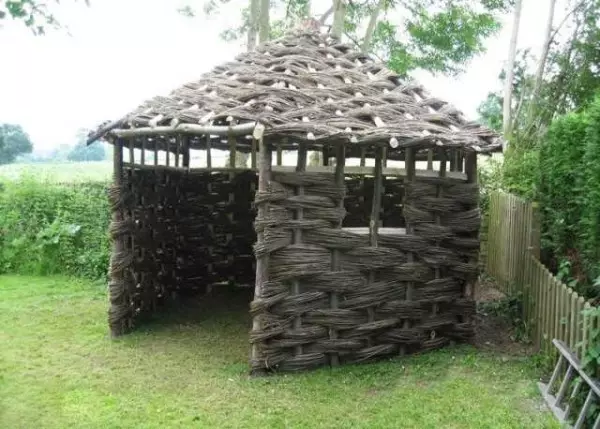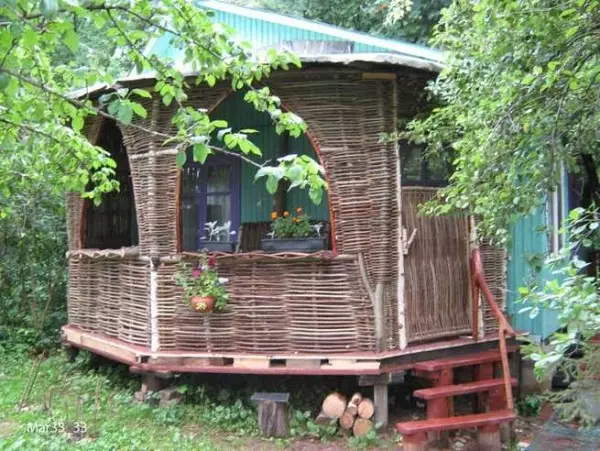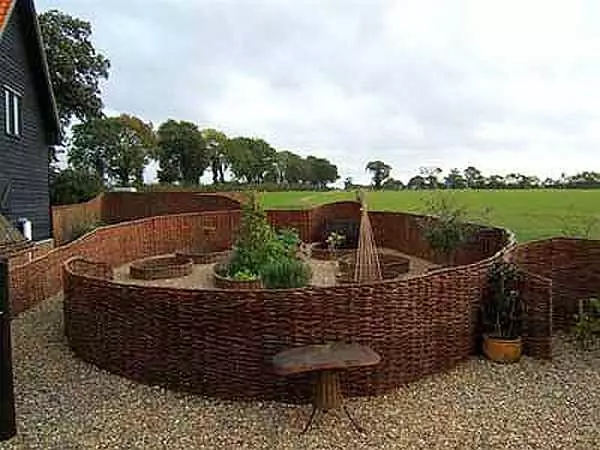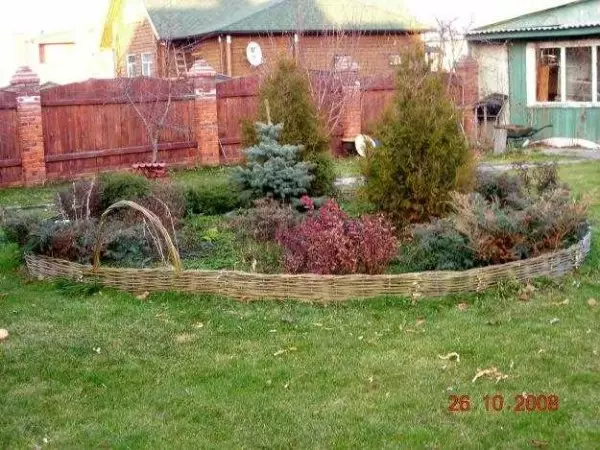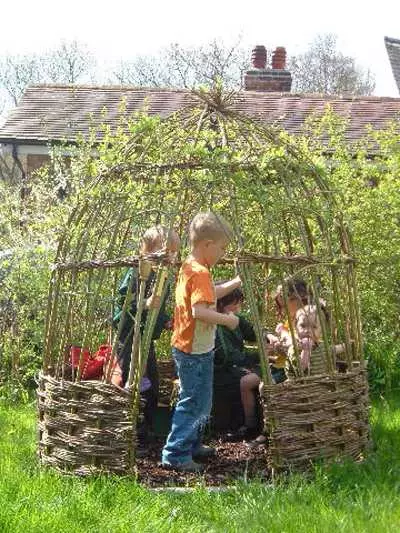The first impression of the house and the dacha make up even before they went into the territory, sometimes - before the house was seen. The first fence rushes. Everything else is after, and the first impression is from the fence. On some, albeit inexpensive, but attractive, I want to stop and see: original ideas always attract a look. One of the most interesting is a braided fence or woven. And they are weaving them not only from the vine Ile branches: there are braids from the boards, but is from PVC rods. They look different in different ways, but interesting and unusual.
What makes a braided fence
Immediately make a reservation that there are two types of wicker fence - "woven" - from branches and "braid" - from the boards. The manufacturer's technique is very similar, therefore they both belong to wicker fences.
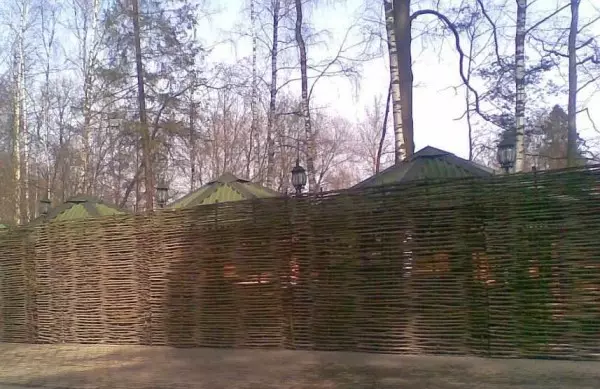
It is a pruck or branches
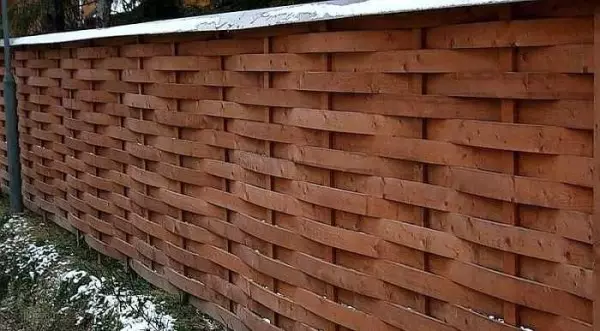
It is a braided fence of boards.
What makes a braid
Now about what you can make such fences. The fence from the board - Austrian braid - make most often from a pine board with a thickness of 20-25 mm, width - about 100 mm. Material - most often - pine. It is more accessible at a price, contains a large number of resins, therefore has a longer service life. But to extend her "life" it is no means that painting with anti-grapple properties.
Poles for such a fence are made from a bar of at least 80 * 80 mm, but more durable from the profiled pipe. Size 60 * 80 mm or 40 * 80 mm, you can take square. It depends on how to mount the board. The span between the supports is 2.5-3 meters, and between them put an intermediate - from a bar of 40 * 40 mm or so. Exactly the span is defined at the place and often depends on the flexibility of the board.
So that the metal poles do not spoil the picture, they are closed with boards that are fixed through studs with plated washers. You can make a base and pillars from the brick, and between them - the braid - vertical or horizontal - depends on your wishes.
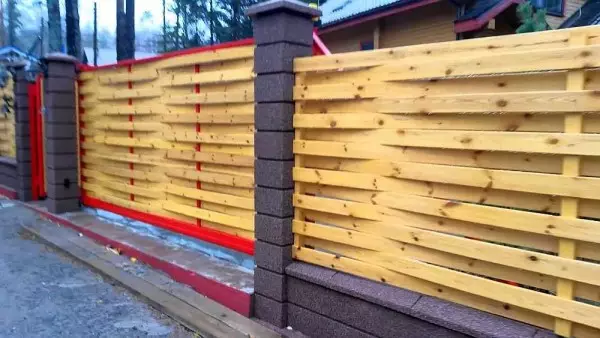
Braid on stone poles
What to use for the shoulder
Rellen makes out of young year-old shoots of several breeds of wood:
- Willow (concrete);
- Oshness (hazelnaya);
- Willow (Krasnoyatal);
- aspen;
- birch;
- PVC rod.
The best - Iva and Oshnik. Their core is dense, which is why the rows of operation solid. The remaining rocks quickly lose appearance and strength.
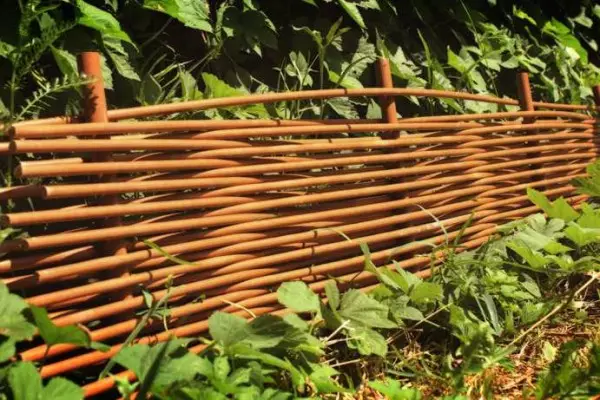
PVC woven - durable and quite attractive
PVC PVC appeared just a few years ago. And although it is not natural, uses good demand: wood, even treated after a few years loses attractiveness. Plastic is not afraid of either the sun, no frost, does not change his kind for a long time. His minus - it needs to be bought, while the vine can be cut.
Article on the topic: What a wallpaper glue to choose for wallpapers
Preparation of Prunev
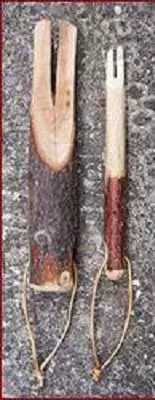
"Cleaner" for bark
The shoots are harvested in early spring or late in autumn, their thickness from 1 cm to 3 cm. For small fences - up to 1-1.2 m high - they go to the twist of the rod - 1-2 cm, to higher - those that are thickening.
It is better to clean the bark on the bar, and they are covered with a mourn or oil for wood. Brown color can be obtained, Ivying the rod in mangartee, gray - in copper cune.
You can use and non-spoiled shoots, but then the bark will begin to flap, the view will be unattractive. Correct the bark is more convenient with a split thick branch or "clever" (see photo). It is easy to make from a suitable size of a piece of branches.
If you are planning to make a fence later, the bundles of the branches are laid in the basement. Before applying the rod for a week they put in the container with water, periodically prevailing it. The rods will swell, elasticity is returned to them, Corre is cleaned easier. If the process is too hard, you can soak branches for another week. Must go easier. To make it easy to ease, you can withstand over the ferry. Then the bark is removed as a banana peel, but the process of "parishing" causes complexity.
Pillars
The basis of any fence - pillars. They can be made of thick smooth branches or trunks of young trees. Diameter is about 5 cm and more if you plan a high woven. To the depth, they are injected or clogged at least 50 cm, the installation step is about 50 cm, it may be greater or less - depends on the degree of flexibility of the prepared vine.So that the posts serve longer, they are treated with bactericidal impregnations, the ends burn on the bore (Dedovsky method), dip in hot bitumen, soaked a couple of days in a solution of copper sulfate.
If the woven fence put for the exterior fencing of the site, as a pillars to use better beam or metal pipes. If the weaving is horizontal, the cross-section of the tube does not matter - in the sense that both round and square are suitable. Even with a round work will work easier. And with vertical weaving, it is more convenient to put pillars from the profile pipe. They are fixed to them, and to a smooth face it is easier to do it.
Types of weaving
In general, it is recommended to master the manufacture of a shouldhell from the simplest scheme - through a pillar. Almost everyone do, and looks good.
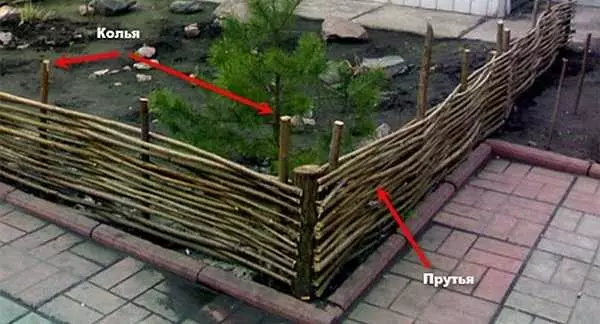
Start with such a simple weaving
Then, making a couple of fences, you can go to more complex drawings. Several schemes are in the photo.
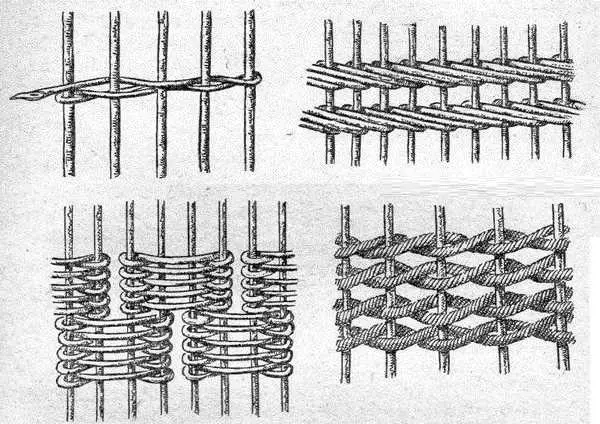
Schemes of weaving fences from a vine and rod
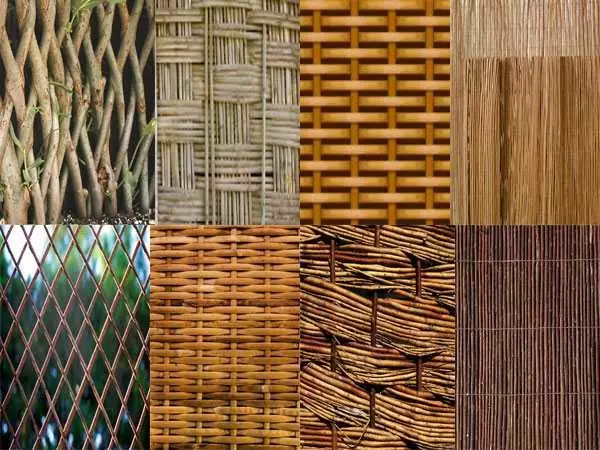
Variations of plowing patterns
How to make a braided fence
We will consider the easiest option - the usual braid. To begin with, it is possible to practice on a small piece - mastering the technique, then you can begin to be seriously constructed. For example, for training, you can make a fence for a bed or a flower bed.Horizontal weaving
We score six more or less thick pegs with a distance of 30-40 cm. We take the first vine, put the "snake" binding between the columns. Line alternately envelopes the columns then in front, then behind.
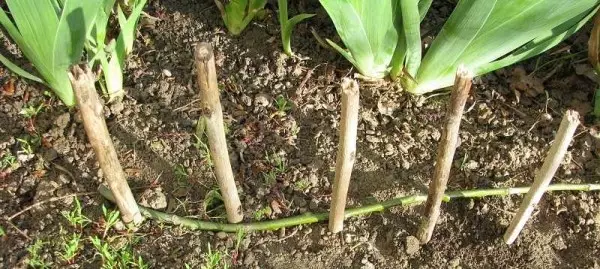
First rod is laid
The second rod lay in the mirror reflection to the bottom. If it starts at the back, then the next fit in front.
Article on the topic: Glass curtains for a bath, reliable way of protection against splashes
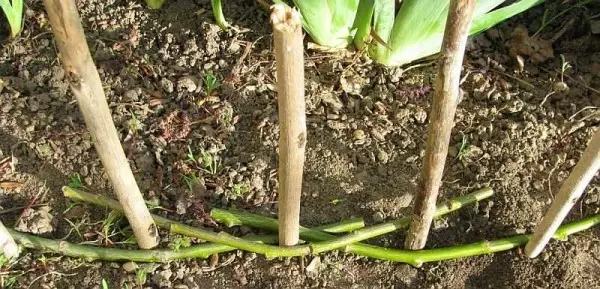
The second rod invested on the contrary
If there is a need to connect two vines, it is done on the nearest column. The next simply laid as a continuation of the previous one. And the protruding ends are cut after everything is collected.
The third, and all odd rows, stacked as the first, fourth and even - as the second. In general, we alternate the beginning of the front from the pillar, then from the back. Periodically, in the intersection of vines and near the pillars, it is knocking on with a wooden hammer, sealing rows.
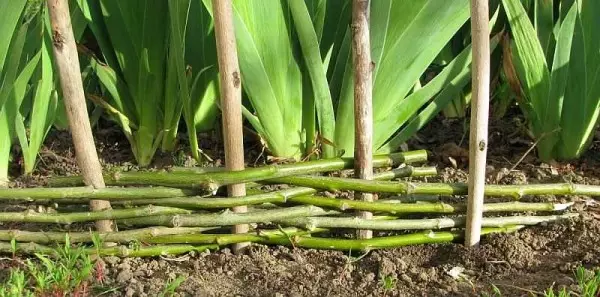
Alternate every subsequent Lozin
This is the horizontal woven. It may be continuous, and maybe shield. With continuous weaving, the poles are installed throughout the perimeter, between them, one after the other, woven the vines. It turns out a practically solid wall - the ends are outlined in one direction and the necosok are cut there so that it is not visible.
If the thick vine is not, you can put a whole bundle of thin twigs at times. It is unlikely that someone will be removed from them with them, and a solid fence will not work either, but the feet is small - easily. It looks like a fence from the rods decoratively, to make it yourself, perhaps, even easier.
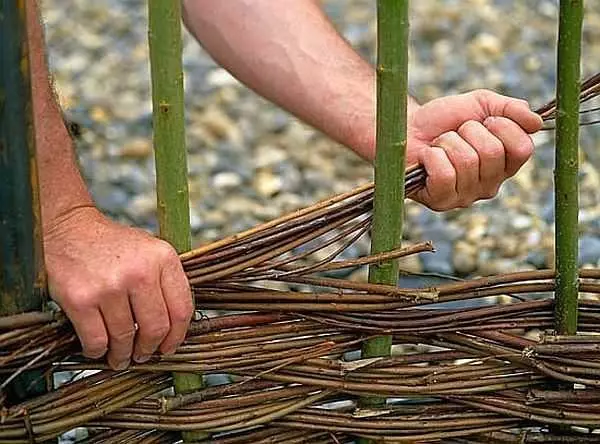
You can use a lot of thin twigs.
When the shield is made of some length sections. Set the desired number of stakes - 4-6 pcs, vines are in between them. After reaching the required height, the ends sticking on the sides are cut off.
If necessary, the edge of the rods are navigated with cloves to the stakes. Such shields are obtained as in the photo. Dimensions can be different - more or less dependent on the desire and type of fence.
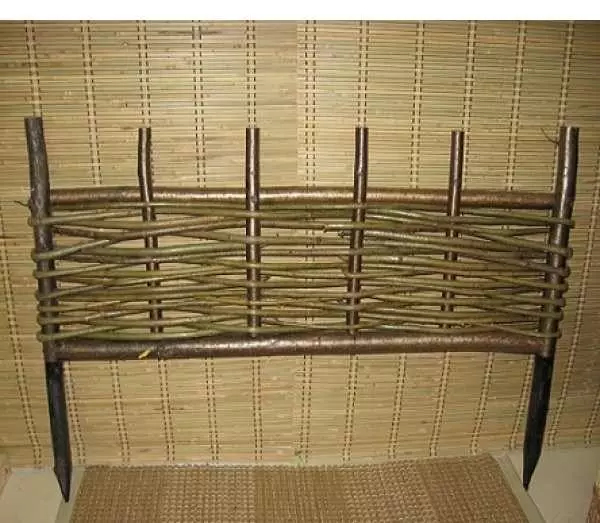
Make type shields such
When the shields are assembled by the required amount, they are installed in place, scoring the pointed ends into the ground. A number of pillars can be associated - for greater stability. It turns out a shield braided fence. An example of the assembly of the Shtren's shields look in the video.
Installation of the shield should be made and using metal columns. No special technologies:
- Drum wells below the drainage depth,
- We throw a bucket of rubble, tamper,
- We put a pillar, set the top and exit the vertical;
- concrete;
- To the Publis, secure ready shields.
One of the options for such an installation in video.
For the same technology, a fence-braid from the boards. Only booted boards, and the span between the columns make more.
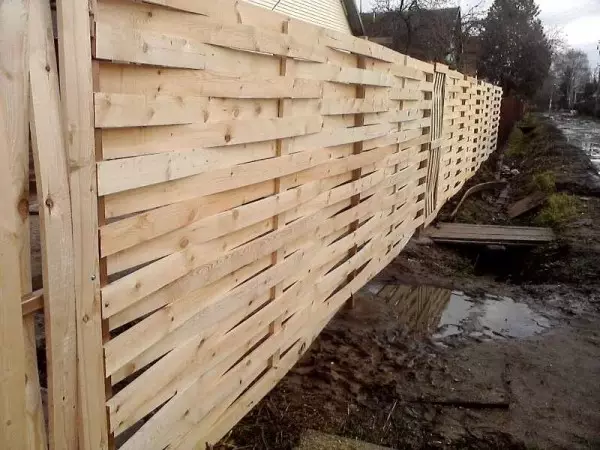
Horizontal braid from boards
Vertical weaving
Bars in a wicker fence can be located and vertically. In this case, three or five crossing are nourished to the columns. The first cross is about 10 cm from the ground level, and then with the desired step.
Weaves so: one end of the rod rests in the ground, for example, with the sides closest to you. Then bend, alternately stretching between the bars. The following escape put on the other hand. It turns out in the mirror image with the previous one. So alternate - ahead / rear.
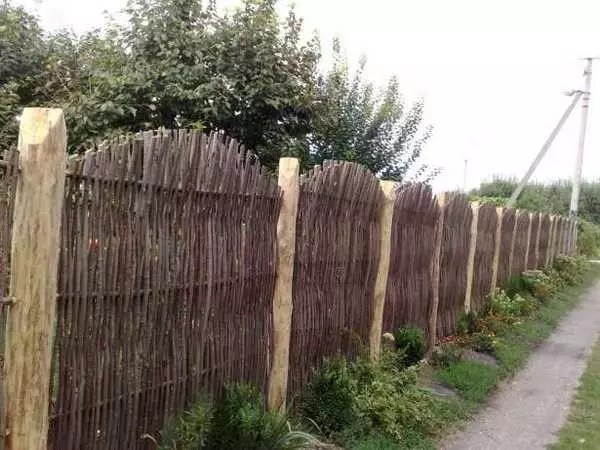
Braided fence with vertical weaving
Since the vine has a noticeable difference in the sizes on top and near the root, then they are paired, then up the thick edge, then down. Then the same density is at the top and bottom. If this is not done, it turns out to be densely, at the top - rarely. How to weave the vertical woven, watch the video - the master class from a person who made it yourself not one braided fence.
Article on the topic: How to fix the channel cable to the wall?
Make vertically and braided fence from boards. Only that he looked organically, and to extend the service life of the boards, the tops are closed with a board packed above. Next to her ends. It still allows you to fix the boards, which in this version is not suitable - sometimes unfinished falls out.
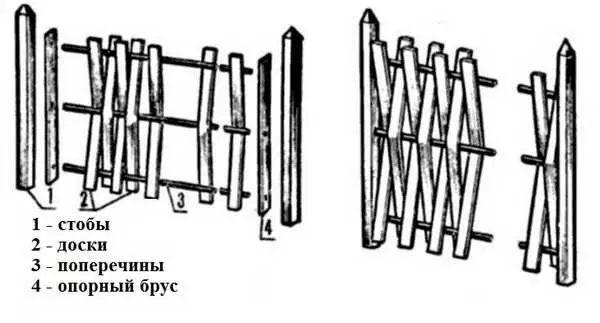
How to make a vertical braided fence
You can fix the boards and to the lower crossbar. Only or on top, or below: so that the wood does not behave when changing humidity. Another moment: if you do from raw board, it is worth considering that I first all without gaps, after drying, you will have between the slot boards in 1 cm. It concerns the horizontal and vertical model.
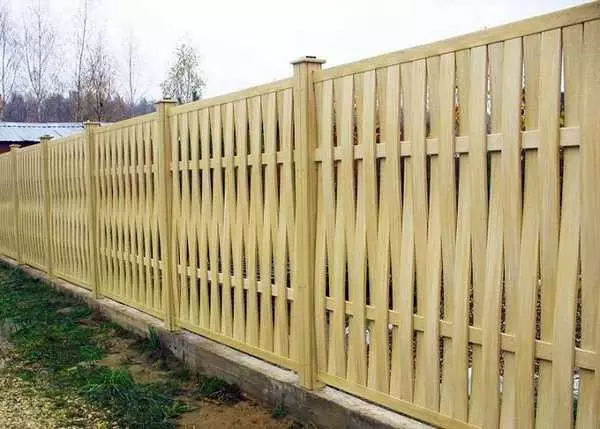
One of the options
The upper and lower crossbars can be made from the profile pipe. This is a more reliable material that guarantees more than greater stability.
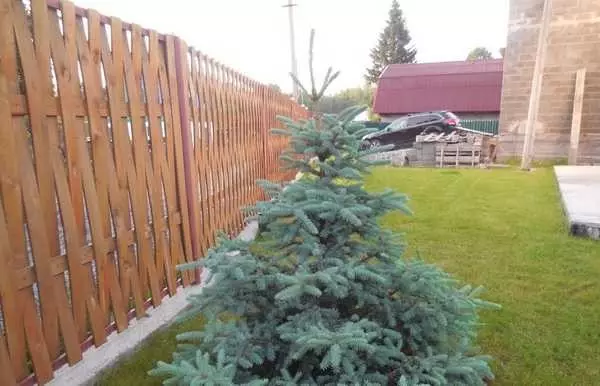
Another option
Photo idea
Many seems to be a hedge of woven rods and branches is only a decorative fence that cannot fully protect the plot. If you look at the next photo, you can doubt it. Wow, such a fence, and almost opaque.
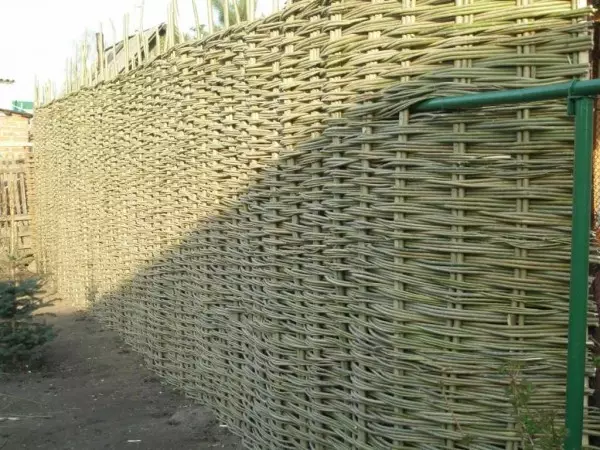
Full fence, no worse than the rest
The main thing in this matter is a solid approach. Put the pillars between which everything is very tight. The service life, maybe small, but also the cost is minimal. And material and temporary.
If the usual weaving is already easily, you can try and do something extraordinary. For example, a braided fence from branches located on a diagonal. And it is also not a frivolous building.
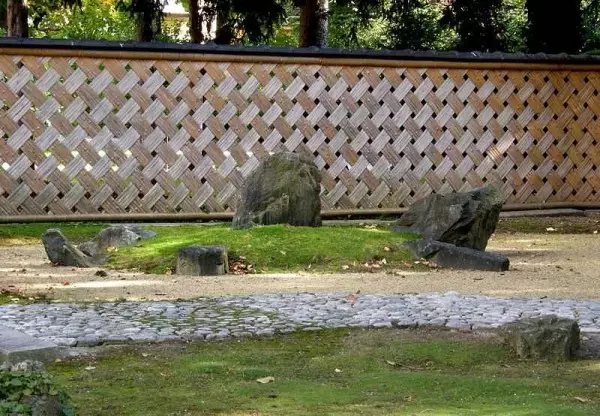
This is already a braided fence more complicated in performance.
There is another interesting way to interlacing - a pigtail. In captured in small areas, it will turn out to do something more large.
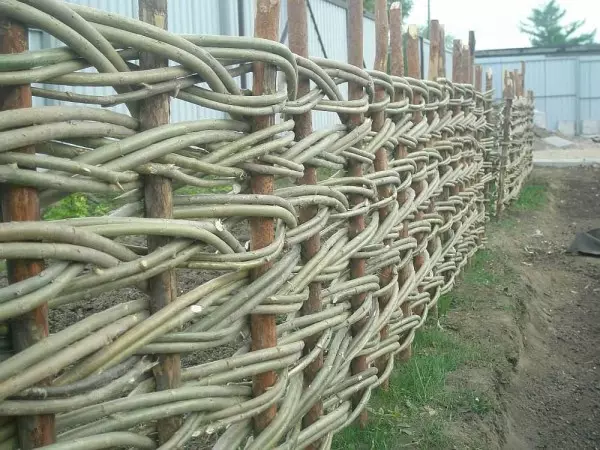
More complex ways, but also more beautiful
If you need a decorative fencing in the yard, in the garden, in the garden, the fence from the branches can be made rare. Even enough thick branches use, but you need to work with them immediately until you have time to dry, or then do not bend.
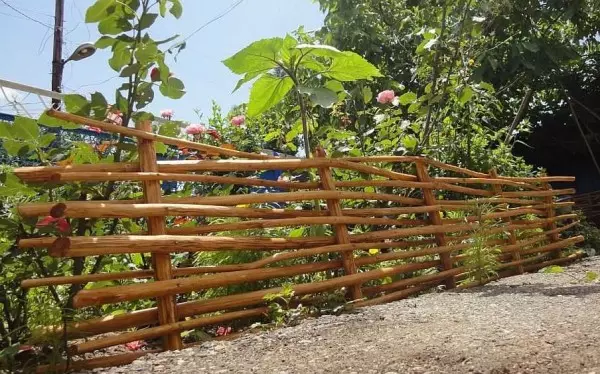
Wild fence with your own hands can be made of thick branches
By the way, if you use fresh cut rods and stick them into the ground, after a while you can get a living fence: Iva is serious. It will be necessary something like that.
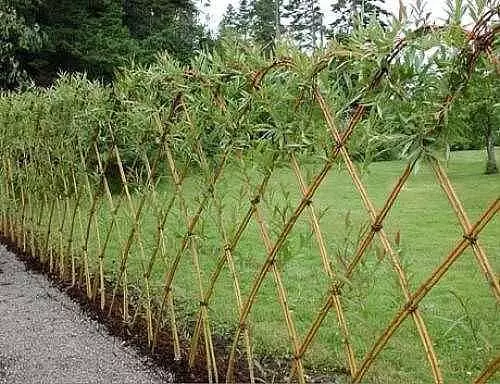
Slowing a fence from willow, you can get a living fence
When landing the alive hedges, use the same intake of intertwing. Only form it from rooted shoots. After they are obsessed, it will be very reliable fence. It is not easy to break through it.
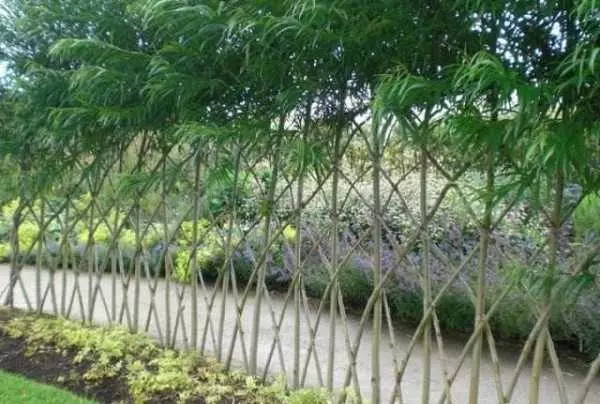
An interesting version of weaving
Next - two photos of wicker fences from boards. Vidny difference in the use of narrower and wider boards. In the first case it is 100 mm, in the second - 150 mm.
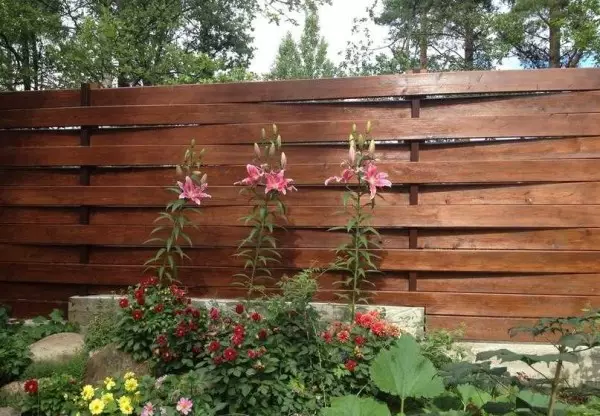
From the board 100 mm
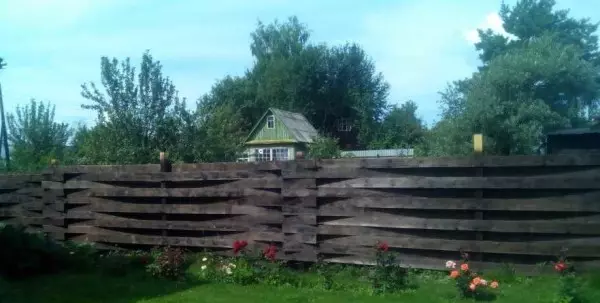
From the board 150 mm
Not only the fence can be made wicker. There are a lot of interesting things, it turns out: gazebo, chalashi, elements of the garden decor.
